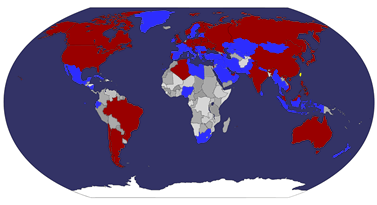The 60th Anniversary of Enforcement of the Local Autonomy Law - Gifu Prefecture/
Le 60ème Anniversaire de Mise en vigueur de la Loi d'Autonomie Locale - la Préfecture de Gifu
Gifu Prefecture (岐阜県, Gifu-ken) is a prefecture located in the Chūbu region of central Japan. Its capital is the city of Gifu. Located in the center of Japan, it has long played an important part as the crossroads of Japan, connecting the east to the west through such routes as the Nakasendō. During the Sengoku period, many people referred to Gifu by saying, "control Gifu and you control Japan."
The land area that makes up modern-day Gifu became part of the Yamato Court around the middle of the fourth century. Because it is in the middle of the island of Honshū, it has been the site of many decisive battles throughout Japan's history, the oldest major one being the Jinshin War in 672, which led to the establishment of Emperor Temmu as the 40th emperor of Japan.
The land area of Gifu Prefecture consists of the old provinces of Hida and Mino, as well as smaller parts of Echizen and Shinano. The name of the prefecture derives from its capital city, Gifu, which was named by Oda Nobunaga during his campaign to unify all of Japan in 1567.The first character used comes from Qishan (岐山), a legendary mountain from which most of China was unified, whereas the second character comes from Qufu (曲阜), the birthplace of Confucius. Nobunaga chose those characters because he wanted to unify all of Japan and he wanted to be viewed as a great mind.
Historically, the prefecture served as the center of swordmaking in all of Japan, with Seki being known for making the best swords in Japan. More recently, its strengths have been in fashion (primarily in the city of Gifu) and aerospace engineering (Kakamigahara).
On October 28, 1891, the present-day city of Motosu was the epicenter for the Mino-Owari Earthquake, the largest earthquake to ever hit Japan. The earthquake, estimated at 8.0 earthquake, left a huge cleft in the ground that can still be seen today.
Gifu (岐阜県, Gifuken) est une préfecture du Japon, située au centre de l'île de Honshu. Le nom Gifu tire son origine d'un mont chinois et a été choisi par Oda Nobunaga qui y construisit son château.
À l'époque féodale, le territoire actuel de la préfecture correspondait à la province de Mino (美濃) pour sa partie sud et celle de Hida pour sa partie nord.
Hida, province montagneuse, était « la principale des provinces à l'est », protégée également par Fuwa no seki (不破関) construit au mont Ibuki.
Sur le territoire de Mino se trouvait le plus élevé des châteaux à Iwamura, à plus de 700 mètres d'altitude. Il surplombait le brouillard qui règne sur les environs, mais est rasé au début de l'ère Meiji pour effacer les traces de l'ancien régime. La province de Mino est également connue pour sa production d'agar-agar (une gélatine fabriquée à partir d'algues).
Pendant la période Sengoku, Saito Dosan et Oda Nobunaga ont régné. Durant la période Edo, le shogun régnait directement.
En 1600 le combat de Sekigahara s'y déroula.
















































 taiwan
taiwan  cover or postcard
cover or postcard  FDC
FDC 





























































































